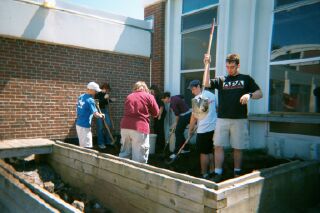Field Training Site
Located in the school's courtyard, the fifteen by twenty foot "sand box" is three feet high and contains over 48,000 pounds of soil. Over ten thousand artifacts, both genuine and reproduced, have been seeded in what is commonly called "the pit". The first level of artifacts simulate Stone Age tools. These Stone Age artifacts were created by the Harvard Archaeological Department in a live demonstration. We taped the Stone Age tool making demonstration and we distribute it as part of our nationwide video exchange bank.
 |
| Students helping to "re-seed" the pit in May 2001 |
The second level of the pit, which represents the Late Woodland Period, was created by Steven Pendery who was then the City Archaeologist of Boston. Pendery demonstrated the process of Indian ceramic making of this period using indigenous clay. The clay artifacts were fired in a homemade kiln in the pit and then buried alongside a wooden wigwam.
The third level, representing the Colonial Period, includes a replica house foundation made of stones. This foundation is so realistic that we even melted clamshells and mussels as part of the mortar used for adhesion. In addition to the foundation, other colonial artifacts like ceramics (stoneware), clay pipes, square nails, wooden buttons and animal bones from cows, pigs and chickens were also buried.
The fourth level, representing the Victorian Period, also includes a replica house foundation as well as Victorian artifacts such as toys, tools, ceramics and bottles.
The fifth and final level is the modern day level. We are emphasizing ecological concepts in this level. Both biodegradable and non-biodegradable artifacts (plastics, beer cans, pop tops, Styrofoam, telephone books, trash bags, baby diapers, etc.) were buried. We are testing artifacts from this level for rate of biodegradability and decomposure.
An Archaeological Classroom Lab
In conjunction with the pit, our archaeological classroom lab is used to analyze, sort and catalog the many artifacts that are excavated. Students learn to wash, sort, identify and catalog artifacts. After these initial tasks are accomplished, students begin the process of artifact analysis and reconstruction. Students learn to date and identify a variety of Stone Age tools, pottery and bone. Countless hours are spent reconstructing shards of pottery and an assortment of bones.
One Summer we ran an archaeological program for handicapped and mentally and physically retarded students that highlighted their exceptional tactile skills in sorting, sifting and artifact reconstruction. After the two week training session, the students had an opportunity to work on an actual dig with the Boston Archaeological Volunteer Program.
-
A Guide For Better Understanding of Archaeology An original online guide by the students of the fall '00 semester.
On Sunday, May 6, 2001, thirteen fine examples of civic virtue volunteered their time, energy, and equipment in Phase I of the re-seeding of the Christa Coorigan McAuliffe Memorial Archaeological Pit in the Beverly High School courtyard. Mrs. McCarthy's Honors Algebra 2 class was integral in the calculation of how much new soil will be needed to fill the new Christa Corrigan McAuliffe Memorial Archeological Pit. The contribution of Mrs. McCarthy's class demonstrated the practical application of Algebra skills in the real world. Kudos!